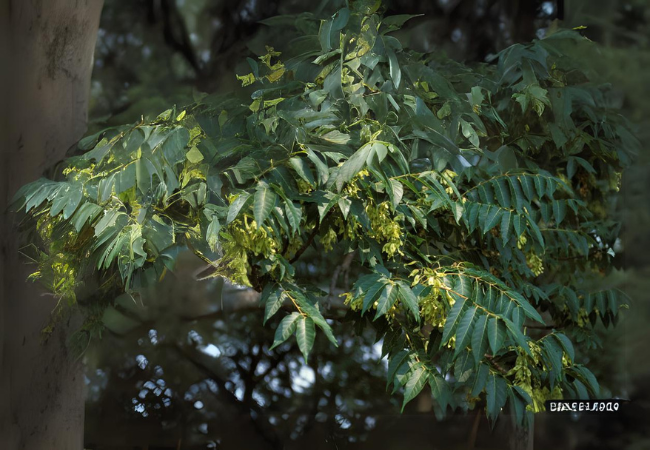- Author: Linda Carloni
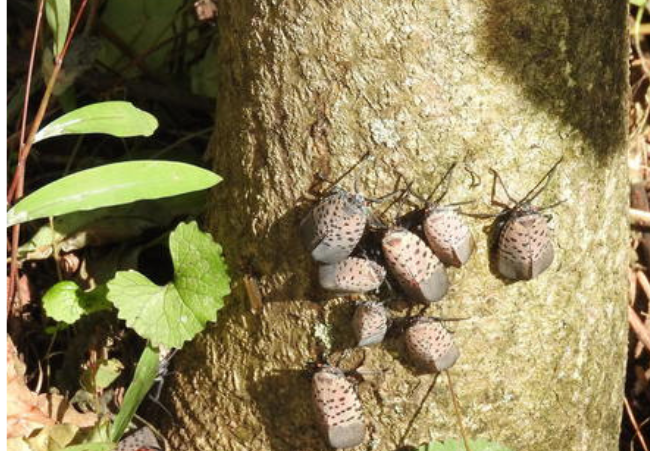
“The one tree in Francie's yard was neither a pine nor a hemlock. It had pointed leaves which grew along green switches… and made a tree which looked like a lot of opened green umbrellas. Some people called it the Tree of Heaven. No matter where its seed fell, it made a tree which struggled to reach the sky. It grew in boarded-up lots and out of neglected rubbish heaps and it was the only tree that grew out of cement. It grows lushly . . .
A Tree Grows in Brooklyn, Betty Smith
Has Tree of Heaven Become the Tree of Hell?
This quote captures well the reasons why Tree of Heaven (ToH) was so popular and is so widespread, as well as the reason why it it's now creating serious problems for both our native forests and our agricultural industries, by spreading rapidly and harboring dangerous insect pests.
Tree of Heaven (Ailanthus altissima) is an invasive plant species intentionally brought to the U.S. It was first introduced in the Philadelphia area in the late 1700s as a botanical curiosity; it is native to China and Taiwan, where it was used medicinally and to feed silkworms. Tree of Heaven (ToH) was later brought to the West Coast in the 1850s by immigrants as a reminder of home.
ToH was widely adopted throughout the 1900s because it was unusual, fast-growing, and tolerant of poor soil and poor air quality. In addition to being traded among individuals, it was widely cultivated by the nursery trade and was even distributed by the USDA. In the early 20th century, it began to lose popularity because of its unpleasant odor, tendency to sprout from its roots and overall “weediness.” As Betty Smith noted, it's frequently found growing out of cracks and crevices of patios and sidewalks, close to foundations and out of stone walls.
Tree of Heaven has reached at least 45 states and is well established in California urban, suburban, agricultural, riparian and disturbed forested areas and along transportation corridors. As of 2018, it was found in 39 of California's 58 counties. So far in California, it has not been found in undisturbed remote wild areas.
Tree of Heaven is considered an invasive pest in much of the US, Europe and Australia, including in California, where it is classified as a noxious weed. Tree of heaven is subject to an external quarantine, and may not be brought into California.
Why worry about Tree of Heaven?
ToH has many of the drawbacks of invasive plants generally - it harms native plants by crowding them out and taking the water and other resources they need, reduces habitat needed by native pollinators and other native wildlife, and can change an area's ecology, particularly streambed areas. ToH brings its own specific harms too:
- ToH is a preferred host to two troublesome invasive insects threatening California: Spotted Lanternfly and the Brown Marmorated Stink Bug. Both have the potential to do major damage to our agricultural crops.
- Toxics in decomposed leaves from Tree of Heaven inhibit the growth of other nearby plants, allowing ToH to take over areas even faster.
- Tree of Heaven impacts human health because it produces a lot of pollen, aggravating allergies. Direct contact with the tree can cause skin irritation. If broken skin is exposed to sap, in rare cases, much more serious problems can occur.
- To make all of this more problematic, Tree of Heaven is hard to remove - you can't rid yourself of it by just cutting the tree down.
What Californians can do AND SHOULD NOT DO to help manage Tree of Heaven
- Don't plant Tree of Heaven and educate your friends and neighbors to avoid planting it as well. If you suspect a tree on your property to be Tree of Heaven, confirm its identification -TOH has look-alikes. California natives that look like ToH include black walnut, sumacs, ash, hickory, butternut and pecan.
- Some helpful ID tips:
- TOH leaves are pinnately compound, which means a central stem within the leaf with multiple leaflets on both sides. The leaf is one to 4 feet long with 10 to 40 leaflets (image A)
- The scar on the main trunk when a leaf is removed is heart-shaped. (Image B)
- The edges of ToH leaves are smooth, but near the base of each leaflet, there are one or two bumps - called glandular teeth. All of the natives listed above have completely serrated leaflet edges. (Image C)
- TOH bark, crushed leaves and male flowers emit an unpleasant odor, sometimes compared with cat urine or burnt peanut butter
- The bark of a mature tree resembles the skin of a cantaloupe. (Cover Image.)
- Video with more ID tips.
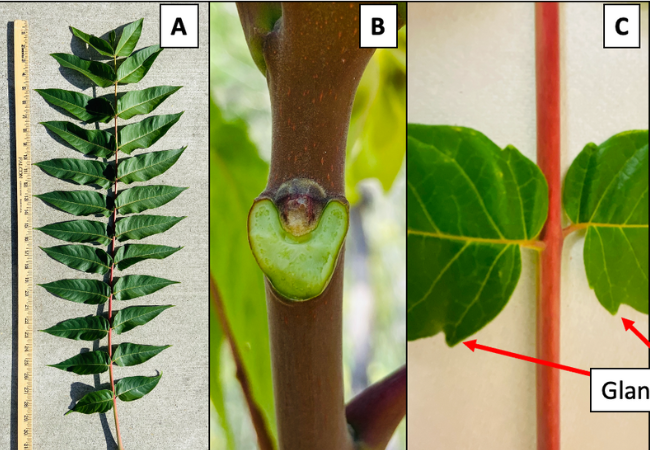 Tree of Heaven, ID Tips, by Cindy Kron, UCIPM
Tree of Heaven, ID Tips, by Cindy Kron, UCIPM - If you have identified a Tree of Heaven, one approach is to monitor it regularly for Spotted Lanternfly and report any sightings. Should Spotted Lanternfly be found in the state or your region, monitoring may require trapping at that point.
- Another approach is to remove the tree. Removing the Tree of Heaven requires specific techniques. ToH cannot be effectively managed by cutting or mowing alone. Cutting alone may just spread the plant. When cut, a Tree of Heaven responds by sprouting exuberantly from its roots, and these sprouts can be up to 50 feet from its parent tree.
- If you are going to remove a Tree of Heaven, be sure to wear long sleeves and gloves to protect yourself when you work near it, because contact with ToH can cause skin irritation. If broken skin is exposed to sap, in rare cases, much more serious problems can occur.If you decide to remove a Tree of Heaven, the recommended treatment protocol is to apply a systemic herbicide to the plant between July and mid-October, when carbohydrates are being sent to the root system, followed by cutting the tree after symptoms of herbicide damage appear, and no sooner than 30 days after application.
- The herbicide may be applied on the foliage on small and/or scattered trees or on the low growth of larger ones. Then follow up with a bark or hack-and-squirt application for larger stems. If doing hack and squirt, make downward angled cuts spaced around the tree between ankle and breast height, making sure to leave living bark between the hacks so the tree can transport the pesticide down to the roots. Treating a ToH stump with herbicide is not effective,
- Applying the herbicide at a different time of year may kill the foliage above the ground, but will fail to kill the roots. Seedlings can be pulled out by the roots, but it is uncommon to see seedlings in California. ToH rarely propagates by seed here, unlike further East. With larger trees, trying to remove the root system will be ineffective.
- After an established ToH is removed, it's recommended to continue to monitor, because additional treatments may well be required in the second year.
Spotted Lanternfly - a Best Buddy of Tree of Heaven
As discussed above, the invasive Tree of Heaven is a preferred host of Spotted Lanternfly (SLF). The Spotted Lanternfly (Lycorma delicatula) is native to China, and entered the US inadvertently. SLF was first located in the US in Pennsylvania in 2014, and is already a significant problem in the Eastern US. It has spread quickly and widely in the Northeast and Midwest, and has been spotted as far north as upstate NY, as far south as North Carolina, as far east as Massachusetts and as far west as Iowa, spurring appeals to the public to "Squish It!.

California is definitely at risk from Spotted Lanternfly. One scientific model found that, without preventative management, SLF has a high probability of reaching the grape-producing counties of California by 2033. In 2021 an external quarantine was imposed prohibiting entry into California of Spotted Lanternfly, its host plants and many other objects coming from areas with known SLF. As of this writing, no live SLF has been found in California, but a viable egg mass was found on a shipment of wood at a Truckee inspection point in June 2024. Even after the load was washed, on re-inspection over 900 eggs were found.
Why worry about SLF?
- California has a lot to lose if Spotted Lanternfly reaches us - grapes, one of our most valuable agricultural products, are a preferred host. Other agricultural SLF hosts include apple and stone fruit, and it also affects ornamental trees. It's very possible that additional plants that we grow in California are susceptible, but are not yet identified because they don't grow in areas currently affected by SLF.
- SLF harms plants by feeding on their phloem, the liquid that transports sugars, proteins and other molecules up and down the plant. This feeding weakens and stresses the plants, can lead to reduced cold hardiness, lack of bloom or fruiting. SLF also produces honeydew, a sweet sticky substance exuded by several insects. This builds up and encourages the sooty mold fungus, which interferes with photosynthesis and can stunt plant growth. SLF can kill grapes and Tree of Heaven.
- ThepotentialeconomicharmfromSLF infestation includes:
- Increased production costs for crops.
- Decreased yields.
- Infested crops may become unsellable - only a small amount of sooty mold on grapes is enough for a buyer to reject them.
- Export problems - areas without Spotted Lanternfly (which include Europe, Australia, Mexico and Canada) may reject exports of our vulnerable crops.
So there are plenty of reasons to be concerned about SLF and to work to prevent its becoming established in California.
What Californians can do to help manage the Spotted Lanternfly threat.
Keep a lookout: Early detection and treatment will help protect our agricultural industries. It is far easier and less expensive to deal with an invasive pest before it establishes itself in the area.
- What does Spotted Lanternfly look like? Eggs, juveniles and egg masses are distinctive in appearance.
- Egg masses vary in size, but typically are about an inch long by 3/4 inch wide. Freshly laid egg masses appear to be coated with a white substance. As they age, the egg masses look as if they are coated with gray mud, which eventually takes on a dry and cracked appearance. Very old egg masses may look like rows of 30 to 50 brown seed-like structures aligned vertically in columns.
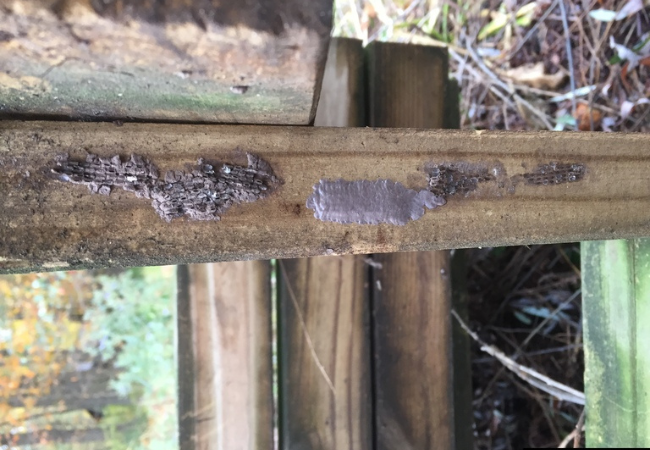
- Young are called nymphs and have four stages, or instars. The first, second and third stages are black with white spots, and increase in size as the stages progress. The fourth stage becomes distinctly red, with patches and black and white.
- Adults are about an inch long and ½ inch wide at rest. SLF has a black head and black legs, with a yellow abdomen. There are two sets of wings. The front of the forewings are gray with a pinkish tinge, spotted with black. The back of the forewings have a gray and black brick pattern.The hind wings are red and black, and are exposed only when the insect is in flight, startled or dying.
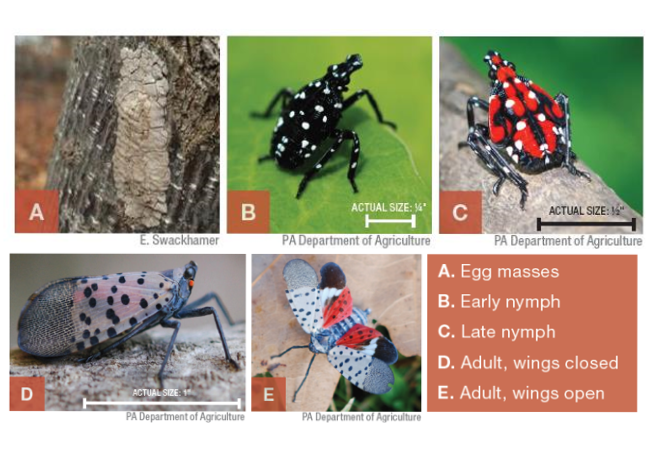 Spotted Lanternfly Collage: Eggs, Young and Adults, by UC IPM
Spotted Lanternfly Collage: Eggs, Young and Adults, by UC IPM
Where to Look
- Egg masses can be anywhere outside, and are frequently found on inanimate objects, such as lawn furniture, kiddie pools, toys, and miscellaneous wood, as well as trees and other plants.
- Look for adults on trees and bushes. Look especially on their preferred hosts: Tree of Heaven and grapes.
Report What You See
- If you see a Spotted Lanternfly, try to collect it and put it in a sealed container or freeze it. If you can't collect it, take as good a photo as you can. Keep a note of exactly where you found it.
- Report your sighting to your local county Agricultural Commissioner's office right away. In Alameda County, call: (510) 670-5232 OR
- Report yourfindtotheCDFA hotline:
- Phone Hotline: 1-800-491-1899 or
- Online at cdfa.ca.gov/plant/reportapest
Working together, the appropriate California agencies, the UC Master Gardeners and Californians at large can help manage the Tree of Heaven and Spotted Lanternfly invasives.
More Information:
UC IPM Tree of Heaven Overview
UC IPM Spotted Lanternfly Overview
Calif Dept of Fish and Wildlife: Invasive to Avoid: Tree of Heaven
UC Cooperative Extension Sonoma: Spotted Lanternfly
UC Cooperative Extension Sonoma: Invasive Tree of Heaven - Host for Invasive Pests
Fresno Master Gardeners: Guidelines for successful tree-of-heaven removal
eLearning course on Spotted Lanternfly in California
Want to learn more?
This blog post is brought to you by the Help Desk of the UC Master Gardeners of Alameda County. Subscribe to our blog!
Have a gardening question? We'll help. You can reach us by:
- Emailing acmg@ucanr.edu. Please include a photo of the problem, if you can, plus your name, phone number, city and a description of the problem.
- Using our online form.
- By phone, during our office hours, 10 am to noon Wednesday and 11 am to 1 pm Thursday: 510-670-5645. At other times, please leave a message and we'll return your call during our office hours.
- In person at our Hayward office, during our office hours, only by appointment.


